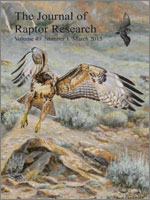With a breeding range extending from approximately 68°N in northern Canada to 8°N in Panama, Red-tailed Hawks (Buteo jamaicensis) exhibit migrations that vary substantially with latitude. Northern populations are almost completely migratory, middle-latitude populations are partially migratory, and southern populations south of 38°N are considered sedentary. Contrary to the latter widely held belief, we found that many juveniles and young adults from one population below 38°N are also partially migratory. However, unlike most birds in the northern hemisphere that migrate south in autumn, young Red-tailed Hawks from our southwestern California study area migrated north in summer to summering areas as far as 1462 km from their natal nests. Of the 5271 Red-tailed Hawk nestlings we banded in the study area and an additional 189 banded by other researchers, 205 were encountered (found dead or alive or recaptured) outside the study area. We classified 64 encountered hawks as potential migrants, most (69%) of which were encountered to the north of their natal nest (median = 383 km). We found that juveniles and young adults banded south of 35°N in the Pacific Flyway migrated north, whereas those banded north of 40°N migrated south. Sixteen hawks from the study area equipped with satellite transmitters as fledglings migrated north (range 342–24°) in summer, up to 1388 km, and returned to their natal region in autumn of the same year. This pattern was repeated annually until they acquired a mate and territory. Our results showed that many or most young Red-tailed Hawks migrate northward in the summer, and we propose that this pattern may be a response to historical climate changes, seasonal changes in sciurid prey availability, and/or dominance of territorial adults.
Con una distribución reproductiva que se extiende aproximadamente desde los 68°N en el norte de Canadá hasta los 8°N en el sur de Panamá, Buteo jamaicensis presenta patrones migratorios que varían substancialmente con la latitud. Las poblaciones septentrionales son casi por completo migratorias, las poblaciones de latitudes medias son parcialmente migratorias y las poblaciones meridionales, al sur de los 38°N, son consideradas sedentarias. Contrariamente a esto último, que está ampliamente aceptado, encontramos que muchos individuos juveniles y adultos jóvenes de una población ubicada por debajo de los 38°N son también migrantes parciales. Sin embargo, a diferencia de la mayoría de las aves en el Hemisferio Norte que migran hacia el sur en otoño, los individuos jóvenes de B. jamaicensis de nuestra área de estudio ubicada al suroeste de California migraron hacia el norte en verano, a áreas de veraneo ubicadas a distancias tan alejadas como 1462 km de sus áreas natales. De los 5271 individuos de B. jamaicensis que anillamos en el área de estudio y de los 189 individuos de la misma especie anillados por otros investigadores, 205 fueron encontrados (muertos, vivos o recapturados) fuera del área de estudio. Clasificamos 64 individuos como migrantes potenciales, la mayoría (69%) de los cuales fueron hallados al norte de sus áreas natales (mediana = 383 km). Encontramos que los individuos juveniles y adultos jóvenes anillados al sur de los 35°N en la vía migratoria del Pacífico migraron hacia el norte, mientras que aquellos individuos anillados al norte de los 40°N migraron hacia el sur. Dieciséis individuos del área de estudio que fueron equipados con transmisores satelitales cuando eran volantones migraron hacia el norte (rango 342–24°) en verano, recorriendo hasta 1388 km, y regresaron a sus regiones natales en el otoño del mismo año. Este patrón se repitió anualmente hasta que estos individuos consiguieron pareja y territorio. Nuestros resultados muestran que muchos o la mayoría de los individuos jóvenes de B. jamaicensis migraron hacia el norte en verano. Proponemos que este patrón puede ocurri





